Have you ever tried to butterfly whole chicken? Or, perhaps you call it spatchcock chicken. Both terms mean the same thing — it’s a method of preparing poultry for cooking by removing the backbone and flattening the bird.
- Butterflying whole chicken helps it cook more quickly and evenly.
- Enjoy even more perfectly crispy skin thanks to the flattened shape.
- You can marinate and season more thoroughly too.
- It’s a lot easier than you may expect!
Every single Thursday (except those that I forget to take a chicken out of the freezer, oops), we have chicken. We call it Chicken Thursday — imaginative, huh?
I choose a different flavour each week because I’ve always had trouble sticking to one thing. But, one thing I always like to do is butterfly whole chicken. The process can seem intimidating if you’ve never done it before, which is why I wanted to share how to butterfly a chicken with all of you.
Don’t miss all of my cooking and baking tips and tricks that you can find here.
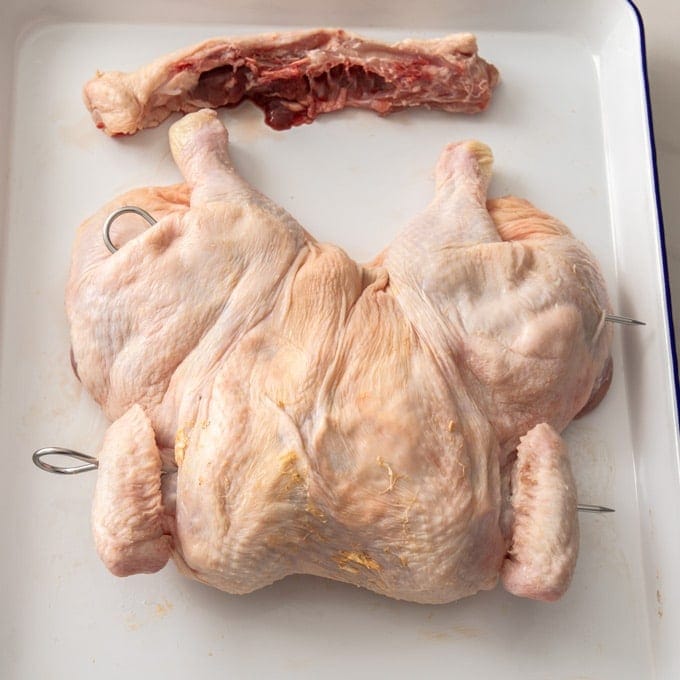
Never Miss a Recipe!
Get the latest recipes straight to your inbox!
What does it mean to spatchcock chicken?
Remember, spatchcock chicken and butterflied chicken are the same thing. It’s the simple process of flattening out a whole chicken before you cook it.
Why butterfly whole chicken?
There are two main reasons you would butterfly (or spatchcock) a chicken:
- If you want to cook it quicker (any way you choose)
- If you want to cook it on a barbecue or grill
The fact that the chicken is flattened out makes it cook more quickly and more evenly.
How to spatchcock a chicken (step-by-step)
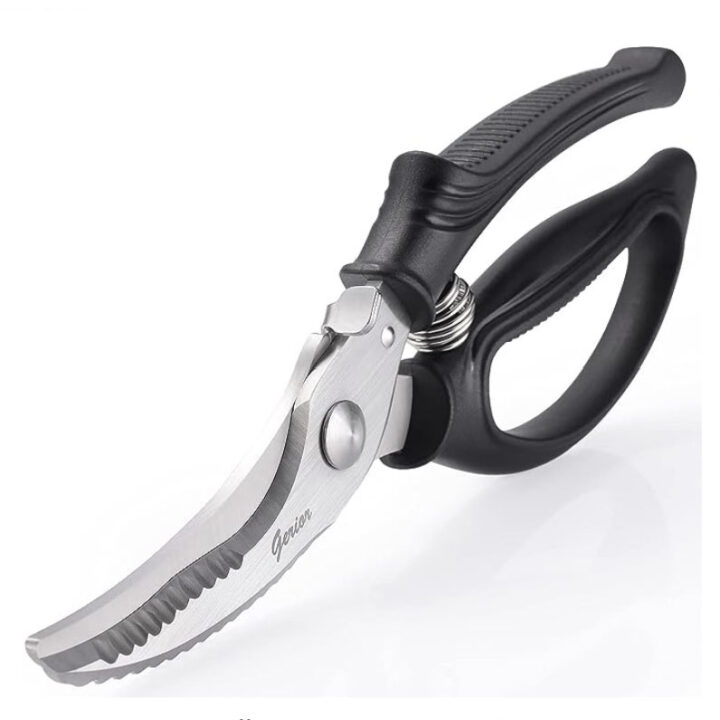
First things first. While kitchen scissors can work, they aren’t really built for the job of cutting through bones without damaging the scissors. Poultry shears are so helpful for cutting through poultry bones with ease so do yourself a favour and grab some. Once you learn how to spatchcock a chicken, you’ll use them regularly.
- Flip the chicken so that it is breastside down on a chopping board.
- Locate the parson’s nose (tail), then use a pair of kitchen or chicken shears (photo 1a) to cut on one side of that, all along the backbone (photo 1b).
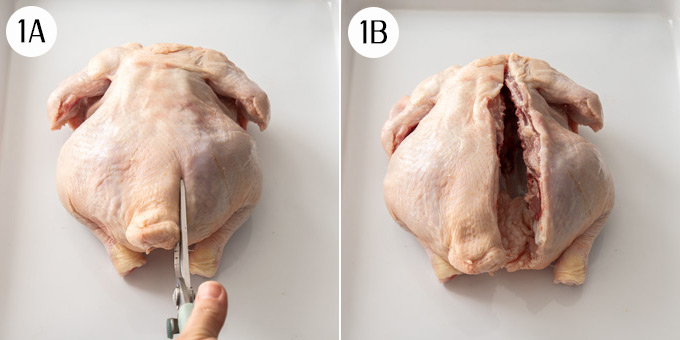
- Cut along the other side of the backbone (photo 2a) to remove it completely (optional) (photo 2b). I actually leave the other side intact most of the time as my hubby loves the parson’s nose and it saves on one cut.
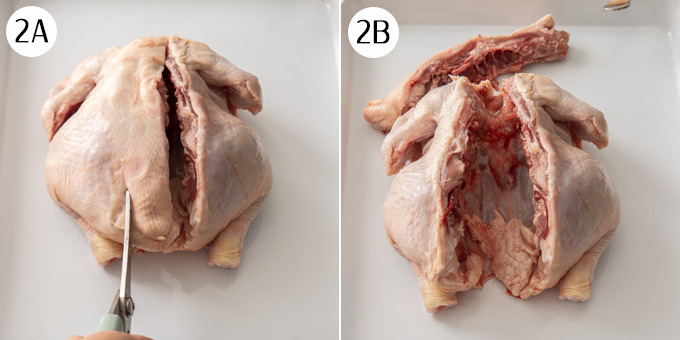
- If it’s a smaller bird you can move on to the next step, however, larger birds benefit from another couple of cuts. Press the chicken out, then locate the collar bone (photo 3a). This will be a thick bone between the wing and the breast bone on each side. Cut this with the shears as well so that it lays flat (photo 3b).
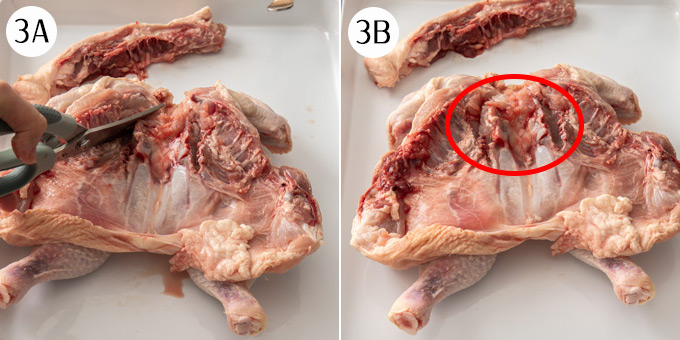
- Flip the bird back over and flatten out the legs. Press down firmly on the breast (photo 4a) to flatten it there as much as possible (photo 4b). If you skipped the last step, you may hear a crack as you break those bones on a smaller chicken.
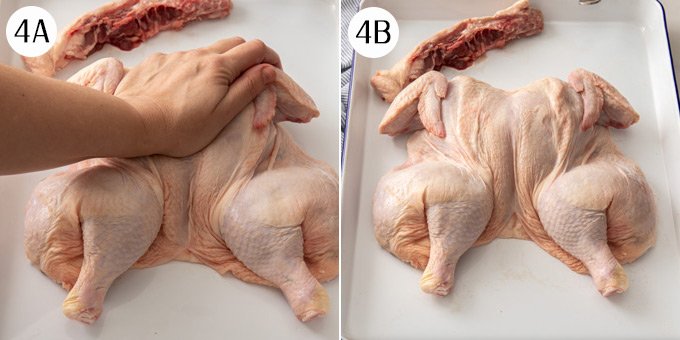
That’s it! You now know how to butterfly a chicken. Pretty easy huh?
How to prepare spatchcock chicken for cooking (step-by-step)
Loosen the skin
Preparation will depend on how you plan to cook your bird, but one thing I always do is separate the skin from the meat. Not to remove it — but to create a pocket under the skin.
- Reach under the skin of the breast of the wing end, as the skin at the leg end is prone to tearing) (photo 5).
- Gently work your hand under the skin over the breast and legs, making sure not to poke any holes in it (photo 6). Now you have a pocket…
- …where you can add extra flavour — flavoured butters (aka compound butters) are great (photo 7).
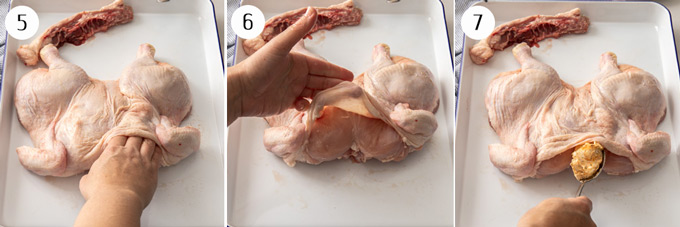
Try my pesto butter for a really delicious flavour.
Skewer it
If you’re going to grill or barbecue your chicken, a great trick is to skewer it. This will stop it from being floppy and make it easier to handle and turn.
- Starting with the legs, push the skewer through the thigh (photo 8), then the drumstick, the tail, and out through the drumstick and thigh on the other side.
- Tuck the wing tips under the wing, then push the skewer through the middle section of the wing, right through the breast, and out through the middle of the wing on the other side (photo 9).
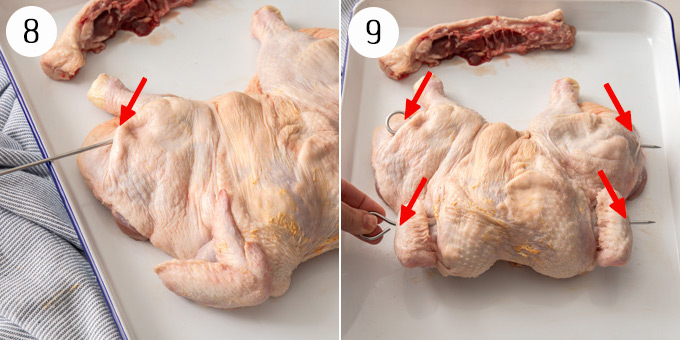
Tips and tricks
- Use the right tools: Use a sharp pair of kitchen shears or a sharp chef’s knife to spatchcock chicken. Remember that you’re cutting through flesh and bone, so you must use something that is quite sharp and sturdy.
- Save the backbone for broth: Waste not, want not. I recommend using the backbone to make a flavourful homemade chicken broth to keep on hand. You can also always freeze the backbone to make a broth for later use.
- To brine or not to brine? Some at-home chefs swear by brining the bird before butterflying whole chicken. It does add extra moisture, which will result in juicier meat. It’s not required, but you may consider trying it! This recipe for pork brine actually works perfectly. Feel free to add some thyme, lemon peel and rosemary too and brine the whole chicken for 8-12 hours.
FAQs
I recommend cooking your spatchcock chicken at 200°C (395°F). Make sure to let the chicken rest for about 30 minutes before you roast it. It will give any seasonings or marinade that you apply the chance to really soak into the meat! Baking time will depend on the size of the bird.
Yes. As mentioned, many people want to learn how to butterfly a chicken because they cook up a lot faster. By how much, you may be wondering? By about 25%.
As mentioned, you can use a very sharp chef’s knife if you don’t have any kitchen or poultry shears. You can also try it with a serrated knife.
There you go, that’s all the tips you need to learn how to spatchcock a chicken. How about trying this Harissa Chicken this weekend?
Did you enjoy learning how to spatchcock a chicken?
Leaving a comment below is so helpful!
Hungry for more? Subscribe to the newsletter for free recipes straight to your inbox. Also, follow along on Facebook, Pinterest and Instagram.
This post may contain affiliate links that earn me a small commission for my referral, at no extra cost to you. Thank you for supporting Sugar Salt Magic.

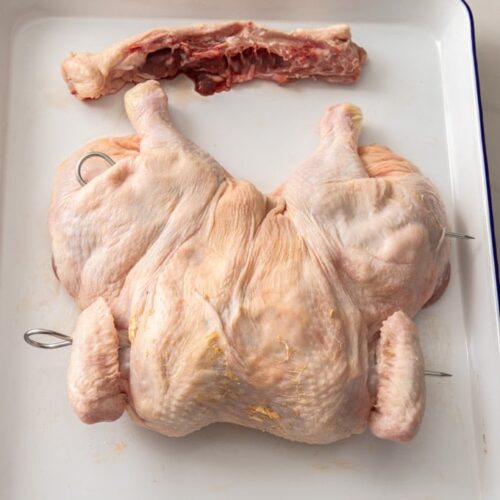
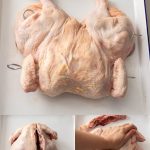

2 Comments on “How to Butterfly a Whole Chicken”
i have a 5 lb chicken. Is that considered a large bord or small bird?
Hello, yes that’s a fairly large chicken.